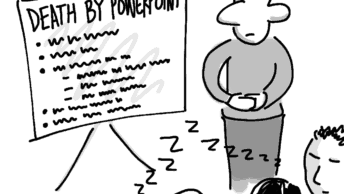I use my red Swingline stapler every day, though I can’t recall actually stapling anything in years.
The colour of the stapler is no coincidence, as my first encounter with a red Swingline was the cult classic Office Space. In the movie, Milton Waddams defends his prized piece of office equipment from theft and destruction at the hands of unscrupulous coworkers.
For Milton and millions of office workers worldwide, the red Swingline has become a symbol of those pieces of our work life for which we would, if ignored, set the world on fire.
My stapler’s daily use is as a reminder that everyone has red-stapler issues in their work life, and that a failure to communicate on those issues could have dire, unforeseen consequences.
It’s an important reminder, to be sure. Our placement in our company’s organisation and workflow means that communicating as a UX professional is both imperative and, at times, extremely difficult.
Here are a few important lessons to learn to help avoid those red-stapler situations.
Learn and translate new languages
My wife and I do not speak the same language.
My wife is an Archivist, and I’m a User Experience Engineer. Unsurprisingly, there is very little crossover between the world of antiquities and modern technology and design. Any dinner table conversation that begins with the inane question of “How was your day?” can lead to a whole meal spent translating different professional terms and concepts into language the other can understand.
This simply goes to illustrate this point: no one speaks the same language. Our individual collections of idioms, slang, and jargon is unique to each of us. What’s more, our own language changes and evolves depending on the group of people we’re interacting with at the moment.
Nowhere is the difference in languages used within an organisation more apparent than in the world of the user experience professional. We have exposure to nearly every element of our business, from C-Level management all the way on down to individual clients.
To be successful in what we do, it’s imperative that we learn to speak and communicate in the various languages of our business partners and clients.
Additionally, because of our involvement across the business, a large part of our job is facilitating communication of difficult concepts between different groups. We are professional translators, addressing a wide audience that speaks a relatively small common language.
To make matters more difficult, UX has its own unique vocabulary that many in the organisation simply won’t understand. This is especially true in organisations that are new to UX. The temptation to slide a word of our own native language into the conversation is overwhelming.
Whether it’s a presentation or an email, we must take a moment before we begin communicating to put ourselves in our audience’s shoes. Potentially confusing jargon, acronyms, and unfamiliar concepts all need to be addressed to effectively communicate to our chosen audience. Identifying these potential issues ahead of time will help you avoid any problems and keep the conversation moving forward smoothly.
Admit your knowledge gaps
Your words mean nothing without the trust of your audience. The quickest route to being known as the office weasel—and quite quickly “the weasel that used to work here”—is to… ahem… massage the truth.
The temptation is real, especially when put on the spot. Unlike developers or QA analysts, UX professionals are often teams of one in many organisations, which means that we often have no one else to call on for help. Additionally, our familiarity with a project from multiple perspectives often forces us to believe we should know more than we actually do.
When our expertise is called upon and the answer evades us, that answer at the bottom of the trash can begins to look really attractive.
It’s a tough lesson that many learn the hard way: audiences can spot a heap of cow caca a mile away. Give that truth a rub down in front of a group more than a couple of times in your career and you will be called out. It will be painful.
At the same time, most people understand that even experts don’t have all of the answers. Additionally, most people don’t care where an answer comes from, so long as it is accurate and timely.
If you’re put on the spot to answer a question outside of your knowledge, simply admitting that you don’t know the right answer holds a lot of power. It projects honesty, humility, and self-awareness, all rare and valued personality traits in designers.
Equally important to admitting “I don’t know” is following it up with the phrase “but I’ll find out.”
The ability to navigate multiple different teams and business partners is a huge part of what we do, and we’re well-placed to find answers or connect individuals across internal boundaries. Always follow up with the requested information or an introduction to the party who can actually help out.
Always take the high road
It’s a guarantee that, eventually conflict will creep into your professional world. Every office is full of conflict, taking a number of different forms. There are egos to manage. There’s office politics in play, at some level, in virtually every decision of importance. There are personality conflicts and disparate goals amongst different arms of the organisation.
Add to that the all-around pressure to perform well, and it means that you will, inevitably, receive some sort of communication that is less than pleasant.
Whether the slights are subtle or overt, in-person or written, when someone lobs a putdown our way, our blood boils and our brain clouds up. Responding in anger is a natural reaction, but it’s not one that will help you accomplish your goals or further your career.
In office environments, anger and resentment are often the result of poor communication. When confronted with an angry or mean communication, take a step back, breathe, and even take a few minutes to calm down before asking yourself “What is this person really mad about, and how can I help resolve their problem?”
The chances are this person is not angry just for the sake of being angry. There is an issue to be resolved, and you have been given an opportunity to help solve the problem.
With our exposure to different business partners and perspectives, UX professionals can often be the key to quick resolution. We have the ability and insight to identify issues and connect key individuals to work towards a clear consensus on difficult issues.
What’s your best communication tip? Leave a comment here, or chat with us in the forums.






I guess this goes out to people coming from all professions. Nice to read some of the insights you’ve shared, precisely the stuff about admitting the knowledge gaps and asking as much as needed to enhance one’s own know-how about things.